Such different worlds: Developed and developing countries
There are more than 200 countries in the world. All countries are very different from each other, with different geographical location, territory, natural environment, climate, population, economy and standard of living. So they are all affected differently by climate change. They also differ by their capacity to cope with the new climate problems.
Countries are often divided into two large groups by their level of development: so called ‘developed countries’ and ‘developing countries’
Developed countries are relatively rich countries with favourable living conditions and strong economies, in which industry, services and the financial sector play a major role. People who live in these countries have access to good health care and education, fulfilling work opportunities, and relatively high incomes that enable them to spend money on restaurants, shopping or travel. The group of developed countries usually includes USA, Canada, Australia, New Zealand, European countries, Japan, Singapore, Hong Kong and Israel. Some countries of Eastern
Europe, including Russia, with so-called ‘transition economies’ represent a sub-group within the group of developed countries.

Developing countries have only recently begun to develop their economies. They are still heavily dependent on traditional industries: crop growing, cattle rearing and mining. They have a lower standard of living, less developed health care system, fewer social programmes for the population, and fewer opportunities for education and employment.

The group of developing countries is extremely diverse. They include emerging economies (newly industrialized countries) such as China, India, South Korea, Turkey, Brazil, Argentina, Mexico and some others, which are rapidly catching up with developed countries thanks to rapid growth of
industrial production. Many of the things that we use every day – clothes, shoes, dishes, furniture, appliances, toys – are made in these countries, particularly in China. China is now second only to the USA by the volume of goods and services, which it produces each year.
On the other hand, there are 47 countries, which are reckoned to be the least developed in the world. They include small-island states, landlocked mountainous countries, as well as countries with overcrowded territories and unfavourable climate conditions. These countries are very poor, their economies are weak, and their people and way of life are highly vulnerable to natural disasters. Most of the least-developed countries are in Africa and Asia, and the poorest of them are Burundi, Congo, Liberia, Sierra Leone, Malawi, Ethiopia, Tanzania, Bangladesh and Zambia.
The poverty in these countries is shocking, with most of the population living on less than 2 US dollars per day. The people are short of food, clean drinking water, hospitals and schools. The governments of these countries cannot pay social security benefits or pensions to its citizens so families there try to have as many children as possible who will help their parents to run the household, work in the fields and support them in old age. Also poor sanitation, lack
of food and clean water, as well as the lack of clinics and hospitals mean that many children die before they can grow up, so having many children is a way of ensuring that at least some of them will survive. About 800 million people (11% of the world’s population) now live in the world’s poorest countries, but these countries contribute less than 1% to the global economy.

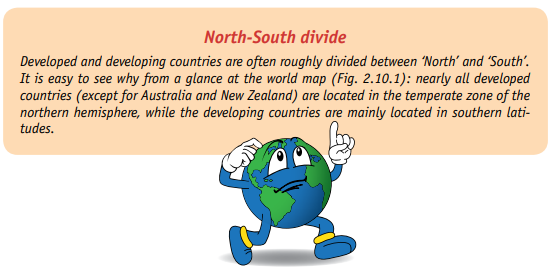
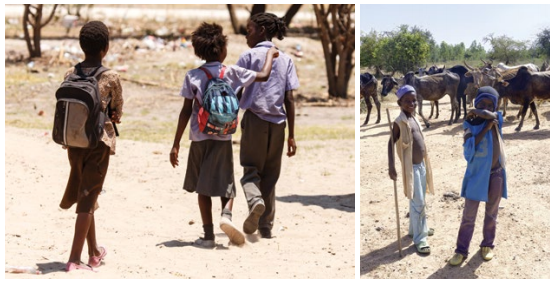
Social inequality
In October 2011, the world population reached 7 billion. The vast majority of the world’s people – 5.9 billion, or 84% of the total – live in developing countries and only 16% or 1.1 billion people (the so-called ‘golden billion’) live in developed countries. At the same time, the 16% of people living in rich countries consume the lion’s share of the world’s production. So the contribution of people living in developed countries to global greenhouse gas emissions
(their so-called ‘carbon footprint’) is much higher than that of people in developing countries, because creation of the daily production consumed by people in rich countries requires a tremendous amount of resources and energy. For example, 3.5 times more resources are required to maintain the life of the average American than to maintain the life of the average inhabitant of the Earth, and the average American uses 9 times more than the average Indian. So the golden billion bear greater responsibility for the consequences of climate change.
The gap between the quality of life of the world’s rich and poor is huge. Average incomes in the richest 20 countries are 37 times higher than those in the poorest 20. So for every 100 US dollars of income received by the average citizen of Europe or the United States, a resident of Nepal or Ethiopia receives only 2.5 US dollars. The incomes of the 500 richest people in the world exceed the total income of the 416 million poorest people on the planet. Worst of all, very high birth rates in developing countries means that their rate of population growth is 3.5 times higher than that of developed countries. The populations of many of the poorest countries in Africa and Asia could double in less than 40 years. So the numbers of the poorest people on the planet is increasing.

It would be a mistake to think that poverty is limited to the least developed countries. Rich countries also have backward regions and poor people. In the US, for example, the numbers of the poor were estimated at 46 million people in 2010, or about 15% of the total population. In Germany, nearly one in seven people, or 11.5 million in total, live on or below the poverty line. Often the poorest people in developed countries are people who came there to work from developing countries, as well as people living in rural areas and declining industrial cities, where mines and factories are closing because they are unprofitable.

But the situations of a poor American and a poor African are quite different! The poverty line in the United States is considered to be an annual income of 22,000 US dollars for a family of four people, or about 15 US dollars per day per person. That really is very little in view of the high prices for essential goods in the USA. But, to a poor African, an American pauper, with his own accommodation, complete with toilet and bath, seems like Rockefeller.
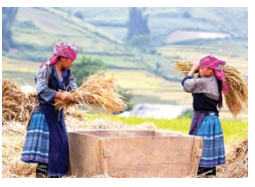
Inequalities in living conditions – unequal distribution of incomes and opportunities between the people of our planet – represent some of the most
pressing social problems in the world today. As was correctly noted in the Human Development Report for 2013 of the United Nations Development Programme: ‘Every person has the right to live a fulfilling life according to his or her own values and aspirations. No one should be doomed to a short life or a miserable one because he or she happens to be from the “wrong” class or country, the “wrong” ethnic group or race or the “wrong” sex.’ Unfortunately, climate change only increases the problem of social inequality and complicates the task of overcoming poverty.
Climate change makes social problems worse
We have already seen how every region and country in the world is experiencing the impact of climate change, but we have also seen how some of them – coastal, Arctic, mountainous or agricultural regions or countries – are more affected by the consequences of climate change than others. This happens because the lifestyle and economy of the local population depends greatly on natural conditions and climate, so that any change leads to major problems for the economy and for society.
People in poor countries and regions depend mainly on agriculture for their livelihoods, so any drought, flood or hurricane can instantly deprive these people of their only source of income. Countries such as Bangladesh, Haiti or Chad are not only among the first to feel the effects of climate change, but they also lack sufficient money and resources to address the potential risks.
Climate change in poor countries has particularly major impact on women, who are mainly responsible for raising children, looking after the sick and elderly, feeding their family, growing crops, and collecting water and fuel. All of these tasks are seriously affected by climate change. In other areas, even in high-income countries, small children, the elderly and people with disabilities may be at particular risk because their health is highly dependent on weather conditions.

Climate migration
Climate change is causing tens of millions of people to migrate in order to escape the effects of storms, droughts and floods. According to estimates, by 2010 there were more than 40 million people in the world who had moved away from their homes for reasons related to climate change. According to forecasts, their numbers may reach 200–250 million by 2050.

Areas threatened with mass migration include the Mekong and Ganges river deltas in South-East Asia. These are densely populated agricultural areas, but forecast rise of the water level in these rivers by 2 m will lead to flooding of large areas of arable land. Local people who work in these fields will be forced to seek new places
to live and work. Frequent droughts or floods, with particularly serious consequences for agriculture, will force many people
in rural areas to move to cities in search of work. Such migration leads to the creation of whole neighborhoods of poor migrants – slums areas with poor sanitation and a high crime rate. An increasing number of people from the Caribbean islands are leaving their homes due to more frequent tropical storms and tornadoes since none of the countries in the region (except for the USA and Cuba) have the capacity to cope with the tougher climate conditions.

Australia and New Zealand have already provided hospitality to climate migrants from the island states of Oceania. Islands in the Tuvalu and Kiribati Archipelagos, located not far from
Australia are gradually disappearing beneath the waves as water levels in the ocean rise.
Environmentalists in Australia are pressing their government to also allocate a special quota for
these climate refugees. Similarly the government of the Maldives has agreed with Sri Lanka on
resettlement of its people if there is imminent danger of this island chain disappearing under
the sea.
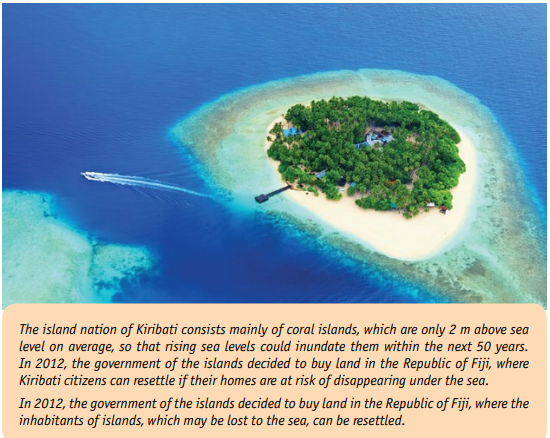
New conflicts
Climate change can cause serious conflicts between people, particularly over the issues of land rights, water scarcity and climate migration. The map in Fig. 2.10.5 shows the possible social consequences of climate change in different
regions of the world. Regions marked in red are particularly at risk of conflicts related to climate change. These are regions threatened by prolonged droughts, water shortages, rising sea levels, soil salinity and crop failures, lack of access to energy and other factors that could provoke political and social crises, as well as increasing migration flows.
International cooperation to provide social assistance
Special programmes of assistance for the most vulnerable society groups are needed in order to reduce the social risks arising from climate change. These may include: training and professional reorientation of people living in rural areas, giving them an alternative profession to agriculture; projects to resettle the inhabitants of threatened regions; the creation of new jobs in poor areas; research to develop new crop varieties that are more resistant to drought; and creation for early warning of natural disasters. But all of these measures require money that poor countries and poor people do not have.
Various funds and financial instruments have already been created to help developing countries overcome social problems associated with the adverse effects of climate change. The main donors are the governments of developed countries, large companies and international organizations, primarily the United Nations.
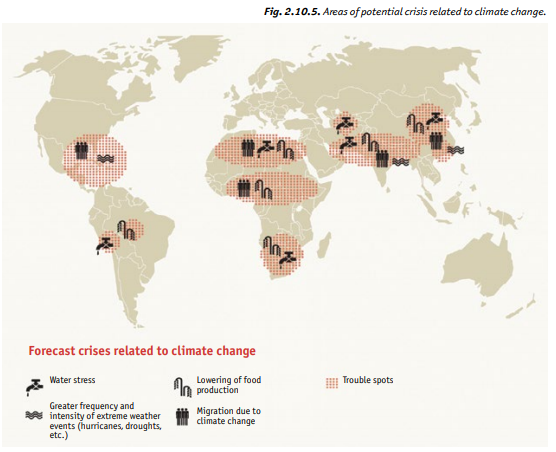
Questions
1. How are developed countries different from developing countries?
2. Do most of the people in the world live in developed or developing countries?
3. Which countries are most vulnerable to climate change? Why?
4. Why do the consequences of climate change have greatest impact on the world’s poor? What social problems does climate change make worse?
5. Animals and plants cannot adapt to rapid changes in climate, but how about people?
Tasks
Task 1. On a map of the world, underline the top 20 countries in terms of economic development and colour them in using a green crayon. On the same map underline the 20 main countries by volumes of greenhouse gas emissions (data can be found in Wikipedia) and colour them in red. Are there a lot of coincidences? How many of the leading
countries of the world are now a ‘dirty brown’, indicating that they cause the most harm to the Earth’s climate?
Explain why these countries are the most to blame for ongoing climate change?
Task 2. Imagine that you are working for an international fund, which allocates money for projects to combat the consequences of climate change. What projects to help poor countries would you finance first and foremost?
